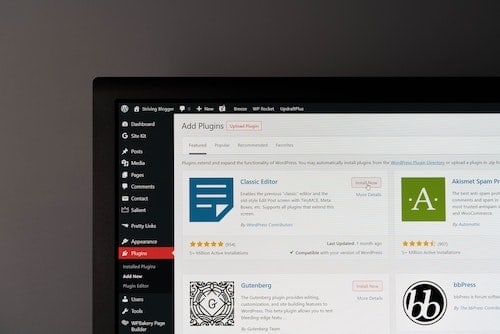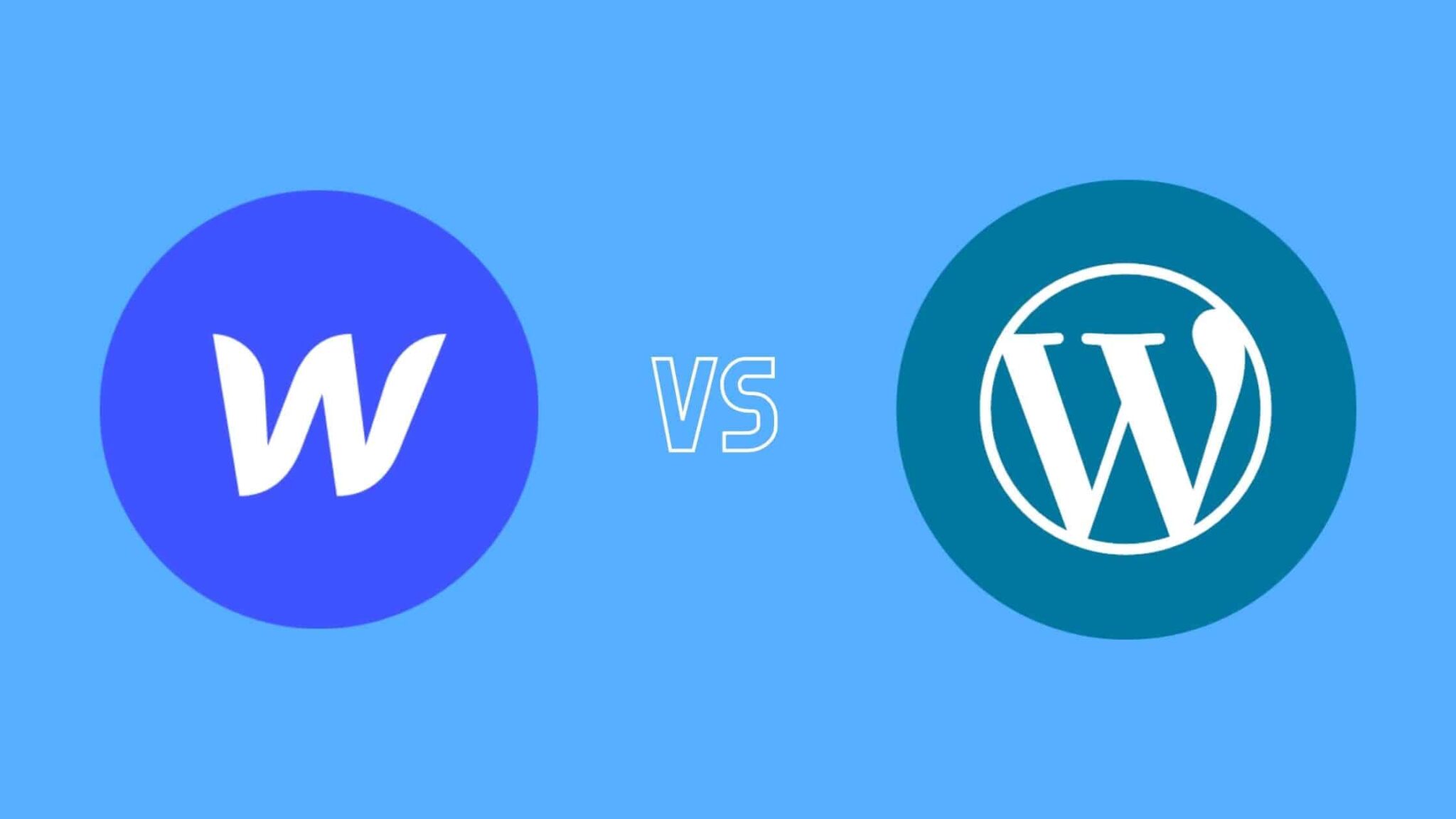We are often asked to compare Webflow vs WordPress. Both WordPress and Webflow are fantastic tools and we use them to build websites for a large number of our clients.
So, which one is best for your business needs?
Webflow vs WordPress – Introduction
WordPress is an open-source platform that allows you to easily build your website. It offers free templates, and many free and paid WordPress plugins are available to add extra features to your site. You can host WordPress yourself if you have your own domain name and hosting, or you can use a service like SiteGround for a small monthly fee.
On the other hand, Webflow is a cloud-based tool with dozens of customizable templates that allow you to create your website without any coding experience. You simply start with one of their pre-built templates, select the features you want, choose a color scheme, and then publish your website using Webflow’s built-in tools.
In this article, we’ll go over the pros and cons of both WordPress and Webflow and guide you into choosing the best platform for your needs.
Ready for the Webflow vs WordPress showdown? Let’s begin.

WordPress Overview
It’s a common misconception that WordPress is only for blogging. That’s only one of many things that you can do with it.
Any time you want to start a website, the first thing you need to decide is what kind of site you want to build. Do you want to:
- Start a personal blog?
- Create an online store?
- Or maybe a business website, portfolio site, or something else entirely?
Once you know what kind of site you want, how much control do you want to have over its design and functionality? Do you want something that’s super customizable and allows you to code every page from scratch? Or are you looking for something simpler and faster to set up, but less customizable?
WordPress is a favorite among users who just want to get their site up and running quickly. It can also be used by advanced developers who want everything under their control. In fact, WordPress is regularly used for all sorts of sites, from simple blogs to complex business websites. We use WordPress for 95% of our projects. Contact us today if you need help building a WordPress website, or have questions regarding the Webflow vs WordPress debate.
Not just a blogging platform
WordPress was originally designed as a blogging platform and it shows. Even today, it’s still the best tool for creating an online journal or publication. The flexibility of WordPress makes it usable as almost any type of content management system. It can even function as an e-commerce platform.
WordPress is an open-source project (different from WordPress.com), which means that anyone can download the free software and install it on their own web hosting account to create a website. There are thousands of free themes available and you can easily build your own custom theme with drag-and-drop functionality.
Because WordPress isn’t limited to just one hosting provider, it has no downtime or performance issues and is incredibly easy to set up and manage for beginners. It also comes with thousands of add-ons and plugins that you can install to extend the functionality of your website.

Webflow Overview
Most software products that are built with a visual drag-and-drop builder also include a raw code editor. This allows non-designers to tweak things and makes it easier for designers to customize their designs even further.
But Webflow goes a step further and gives you access to the entire codebase of your website. This means you can edit the HTML, CSS, and JavaScript directly if you want, or you can add dynamic features like a blog, e-commerce store, directory, or anything else you can think of.
Webflow is relatively simple by design. It’s not a full-fledged development platform like WordPress or Drupal. But it’s incredibly powerful and flexible as a tool for building websites using nothing but code.
Webflow features
Webflow can be divided into two parts:
- a visual builder
- a CMS
The builder is used to build the actual visual elements of your site. If you want to add a text box, or a button, or change the layout of a page, you use the builder to do that.
The CMS allows you to add dynamic content to your website; it lets you create pages that have multiple sections, and include features like blog posts, product catalogs, and e-commerce stores.
Because Webflow offers these two different tools for building your website, whether or not it’s right for you depends on the type of website you’re trying to build. If you’re building a static site with simple pages and no need for dynamic content, then Webflow’s visual builder is all you need. If you’re building something more complex, then the CMS will probably be useful as well.

Extensions and plugins
WordPress plugins
The WordPress library has thousands of plugins and most of them are free. This is because WordPress developers want to give back to the community, either by offering truly useful plugins and themes for free or by making money by selling premium plugins and themes.
With so many options to choose from, you can use plugins to do almost anything you want with your site.
For example, if your business specializes in selling widgets, you can add a custom widget plugin that will allow users to purchase widgets directly from your site. Or, if you run a local business, you can add a plugin that will give users a Google map with directions and distance to your location. No matter what you need, there’s probably a plugin available that will do it for you. This extensive availability of plugins and extensions tips the scales in the Webflow vs WordPress debate.
Plugin Examples
Here are just a few of the plugins that you can use to enhance your site:
- All In One WP Security & Firewall – This plugin allows you to block malicious requests and display a login screen to any guest user, even if they’re not logged in. You can also change the login URL and add an option to generate a random string as a replacement for the default ‘Log in’ link.
- Contact Form 7 – This plugin lets you create contact forms, polls, and surveys on your WordPress website. It also includes over 100 free templates for you to choose from.
- Google XML Sitemaps – Sitemaps allow search engines to index your website more efficiently and make it easier for users to find what they’re looking for. Google XML Sitemaps is one of the most popular plugins of its kind with over 2 million downloads.
- Yoast SEO – If you want your website to rank well in search engines, then this is an essential plugin. It will help you optimize your posts so they appear higher up in search results.
There are thousands of other plugins out there that you can use to improve functionality, increase security, streamline workflow, or do all three!

Webflow extensions
Webflow doesn’t offer the same kind of plugin support that WordPress does. It isn’t open-source, and you don’t have access to the code. That means that you can’t install plugins directly in the Webflow interface.
The company does offer some features if you’re willing to integrate code from your own solution providers and connect third-party services.
Thing is, you can do this with WordPress too. The difference is that WordPress allows you to add native extensions in the form of plugins that work within the WordPress interface. It’s much easier than setting up integrations piecemeal via snippets of code.
If you want to use an SEO plugin or another similar service with WordPress, you can go through the native plugin system. If you want to do the same with Webflow, you’ll need to integrate code snippets from third parties.
The integration issue is especially frustrating because it’s not just Webflow’s integrations that are lacking. If you want to build a site that uses eCommerce, for example, you’ll need to integrate with a separate eCommerce platform and then add that functionality to your site in Webflow.
But many of the other tools you might want to integrate with aren’t supported by Webflow yet either. You won’t find support for Google Analytics or Facebook Pixel. Some services, such as WordPress’ Jetpack, only work if you have a custom domain name (something Webflow doesn’t offer).
All told, this means you may find yourself spending as much time building integrations on top of Webflow as you would building the actual site on a different platform. That can be time-consuming and frustrating and tips the scales in the Webflow vs WordPress debate.
So, let’s explore which platform is best for e-commerce.
WordPress vs. Webflow for e-commerce
If you’re planning to launch an e-commerce website, the WooCommerce plugin might be your best bet.
The Woocommerce Plugin is a free e-commerce plugin for WordPress that allows you to add a powerful, easy-to-use e-commerce system to your WordPress-powered website or blog.
You can use the WooCommerce plugin to sell physical or digital goods on your website. The plugin has been tested with over 1,000 different payment gateways.
The product catalog allows you to organize products using custom taxonomies and attributes, including variations and bundled products. You can also add related products to your products.
However, if you’re planning to build your e-commerce website using Webflow, you should know that you’d need to pay for the e-commerce plan which starts at $29 per month, billed annually.

Pricing
WordPress pricing
A WordPress website is a free website, but to run one, you will need to pay for both web hosting and a domain name. If you are looking for more information on all you need to launch a website, check out this article.
If you just want to “publish” information (like this blog post), WordPress will work just fine without any additional features or design. However, most WordPress sites are built with some degree of customization that requires the use of either premium themes or premium plugins.
Premium themes and plugins can cost anywhere from $10 to $100+, depending on what feature set you’re looking for. And while some premium themes and plugins are sold under a “use forever” license, some of them impose restrictions on the number of sites that can use them (for example, you might need to purchase a license for each site you want to use them on).
The minimum cost of getting started with WordPress is whatever the price of your chosen hosting and domain name is.
Webflow pricing
Webflow offers two types of plans you can choose from depending on the scale of your business. The first is the Account plan, and the second is the ‘Site’ plan.
While Site plans are designed for individual websites or portfolios, an Account plan is made for businesses.
The Site plans start at $12 per month for websites that don’t need a CMS and can go up to $36 per month for websites that expect larger amounts of traffic and extended marketing capabilities.
On the other hand, Account plans have a free starter plan, and two additional plans at $16 and $35 a month, respectively, for features that allow you to export the code and incorporate more premium features.
While the WordPress pricing might look more attractive, keep in mind that you will have to pay for hosting which can cost just as much as Webflow monthly licensing (and sometimes even more).
Another important consideration to consider is the Enterprise licensing tier in Webflow. If your website could grow to over 10,000 CMS “items”, you may get bumped to Enterprise level pricing, which can cost around $65,000/month. Although 10K items sounds like a lot, this also includes images, and other CMS assets which can add up quickly.
SEO Considerations
Search engine optimization (or SEO) can be implemented on both of these platforms. However, if your goal is to focus on SEO, we recommend WordPress due to the many available integrations and extensions.
We believe that WordPress just can’t be beaten when it comes to SEO, and in this article, we outline why.

Webflow vs WordPress – Conclusion
In summary, we prefer WordPress for building websites in 2024. Due to the extensive features and SEO benefits, WordPress is more aligned to what our clients are looking for and doesn’t tie our hands in the future.
Nat Miletic, Clio Websites. Webflow vs WordPress – The Definive Guide 2024 Guide
WordPress started with blogging functionality but has since expanded its capabilities to provide a state-of-the-art CMS. This wide range of features makes it easy to create practically any type of website with WordPress.
WordPress is popular because it’s flexible, reliable, and powerful. In contrast, Webflow is a SaaS application that doesn’t have the same flexibility as WordPress but does offer a simpler experience for creating great-looking and fast sites.
If you’re planning to create content-focused websites like blogs or news sites, or e-commerce sites, WordPress is a great choice. If you’re building more interactive or design-driven sites, Webflow is a better option. If you aren’t sure which tool is right for you, try out both, or get in touch with us!
We hope that our article helped you make a decision regarding the Webflow vs WordPress debate. If you decide to move your website from webflow to wordpress, read our step-by-step guide.
Find out more in our previous article, in which we compared Drupal and Wordpress.
About Clio Websites
Clio Websites is a full-service website design and marketing company in Calgary. We have vast experience in responsive website design, website maintenance, WordPress development and support, and SEO. Clio offers free consultations and free website evaluations and we receive glowing reviews from our clients.
We have experience building both Webflow and WordPress websites and both platforms have their own advantages and disadvantages. If you are looking for help deciding which platform is better (Webflow vs WordPress), contact us today.
We are always available and happy to answer any questions you may have so don’t hesitate to get in touch with us.
Webflow vs WordPress FAQs
Can Webflow be used with WordPress?
No, Webflow and WordPress are different platforms that can’t be used together. Both solutions have a content management system and offer e-commerce capabilities.
Is Webflow bad for SEO?
Webflow is not bad for SEO. Search engine optimization can be implemented using Webflow just like any other web development platform. However, we believe that it’s easier to implement SEO with WordPress.
Do professional web designers use Webflow?
Yes, professional web designers use Webflow. Webflow is a great solution for building websites quickly and efficiently that meet various client needs.
Which platform is better, Webflow or WordPress?
WordPress and Webflow are fantastic tools and we use them to build websites for a large number of our clients. They each have their own advantages and disadvantages. If you are looking for help deciding which platform is better (Webflow vs WordPress) contact us today.



